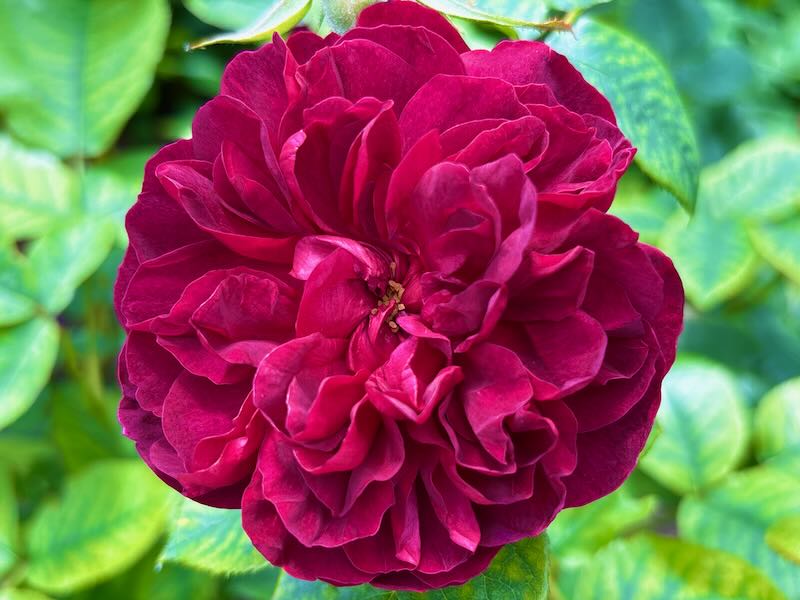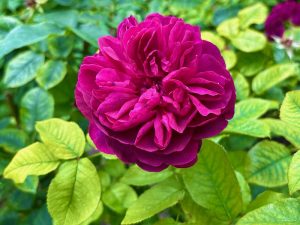Rosa ‘Darcey Bussell’: compact crimson rosettes with ballet-worthy poise
Rosa ‘Darcey Bussell’ opens in rich crimson-pink, then softens to a hint of mauve just before the petals fall. This English Shrub Rose from the Rosaceae family stays compact, repeats generously, and perfumes the border with a light to medium fruity scent. Bred by David Austin and introduced in 2006 under the breeder code ‘Ausdecorum’, it also appears in catalogs as the Darcey Bussell Rose, English Rose ‘Darcey Bussell’, and David Austin Rose ‘Darcey Bussell’. Whatever name you prefer, you get a small, bushy shrub that flowers hard from late spring to frost and holds color even in bright sun.
The plant grows into a neat, rounded mound about 90–120 cm tall and wide (3–4 ft by 3–4 ft). Stems carry glossy, mid- to deep-green foliage that frames each flush of blooms. Buds open with an outer ring of petals that cradle a cupped center, then relax into tidy, medium rosettes with around 70 petals per flower. You notice the fragrance as you pass—a clean, fruity note that reads fresh, never heavy. Because the shrub stays compact, it suits small front gardens, tight borders, low hedges, and large containers.
The story behind Rosa ‘Darcey Bussell’
David Austin bred this rose for strong color in a manageable package. He combined old-rose charm with modern repeat blooming, then named the result for the acclaimed ballerina Darcey Bussell. The cultivar quickly became a favorite in mixed borders because it partners well with blues, silvers, and soft pastels. Gardeners also praise its steady habit in heat and its willingness to rebloom when you deadhead.
Flowering season of Rosa ‘Darcey Bussell’
Expect a long run. Flowers begin in late spring as temperatures rise. The shrub then blooms in waves through summer and into autumn. In warm regions with mild early winters, the last clusters can linger into November or even December. You drive repeats by removing spent clusters and feeding lightly after each major flush. In cool summers the color deepens; in heat the tones shift toward raspberry and crimson without losing presence.
Color, fragrance, and vase life
Freshly opened blooms show a saturated crimson-pink. As each rosette matures, the outer petals relax and the inner whorl keeps its shape. Right before petal fall, a soft mauve cast appears. The perfume lands in the light-to-medium range with a fruity theme and a hint of green apple. For cut flowers, harvest stems when one bloom is open and the rest show color. Recut under water and place in a clean vase. With cool indoor temperatures you enjoy five to seven days.
Landscape uses for Rosa ‘Darcey Bussell’
Use this rose where you want depth of color without excess height. It anchors the front of a mixed border, edges a path, or forms a low flowering hedge. In tight urban courtyards, a single specimen in a wide pot brings months of color at eye level. It also pairs beautifully with companion plants that cool or echo the bloom tones. Think Nepeta for a haze of blue, Lavandula for silver and scent, Salvia nemorosa for vertical rhythm, and airy Gaura to keep the composition light. For a jewel-box scheme, underplant with heucheras in plum and dusky pink.
Environmental tolerances of Rosa ‘Darcey Bussell’
This cultivar handles a range of garden conditions. It thrives in full sun but tolerates light afternoon shade in hot inland sites. Once established, it endures short dry spells, although deep, regular watering produces larger blooms and glossier leaves. It manages humidity better than many crimson roses if you give it space and morning sun to dry the foliage. In cold regions, it overwinters reliably with mulch and a late-winter prune. Most gardeners treat it as hardy in USDA Zones 5–9; in 10–11 you can grow it with afternoon shade and a cool root zone.
How to Grow Rosa ‘Darcey Bussell’
Light
Plant it in full sun whenever you can. Aim for six to eight hours of direct light each day. Morning sun matters most because it dries dew and lowers disease pressure. In regions where summer highs exceed 35 °C (95 °F), provide dappled shade after 3 p.m. to protect petals and conserve moisture.
Soil
Give this rose fertile, well-drained ground. A loam enriched with organic matter works best. Target a pH near neutral—about 6.0 to 6.8—but the plant adapts to slightly acidic or slightly alkaline soils if drainage stays sharp. In heavy clay, open the top 30–35 cm (12–14 in) with compost and coarse grit to keep winter wet away from the crown. In sandy ground, blend in compost to hold water and nutrients.
Planting
Plant in spring or autumn for the surest start. Dig a hole at least 45 cm across and 30–35 cm deep (18 in by 12–14 in). Roughen the sides so roots can move outward. Set the plant so the bud union sits at soil level in mild climates or 2–5 cm (1–2 in) below soil level where winters bite. Backfill with your native soil, amended but not replaced. Firm gently to remove air pockets, then water to settle the roots. Space plants 75–90 cm apart (30–36 in) for airflow and clean growth. In formal rows, keep the line straight but avoid crowding; healthy foliage is part of the show.
Watering
Water deeply and then wait before you water again. During the first season, soak the root zone whenever the top 5 cm (2 in) of soil dries. Each soak should penetrate 20–25 cm (8–10 in) deep. In established plantings, one deep watering per week usually suffices in moderate weather; increase to twice weekly during heat waves. Always wet the soil, not the leaves, and water early in the day. A moisture-meter reading or a simple finger test prevents guesswork and guards against overwatering.
Mulching
Mulch helps this rose look its best. Spread a 5–7.5 cm layer (2–3 in) of shredded bark, compost, or leaf mold over the root zone. Keep it a few centimeters from the canes to prevent rot. Mulch steadies soil temperature, conserves moisture, reduces splash-borne disease, and feeds soil life as it breaks down. Top it up each spring and again in midsummer if it thins.
Fertilizing
Feed for repeat bloom, not just leaf growth. In early spring, apply a balanced, slow-release rose fertilizer at label rates, or scratch in 2–3 liters (about ½–¾ gal) of mature compost per plant. After the first heavy flush, feed again with a balanced product or an organic blend that includes potassium for flower strength. In long growing seasons, a light midsummer feed keeps momentum. Stop fertilizing six to eight weeks before your expected first frost so new shoots can harden before winter.
Pruning and deadheading
Prune in late winter or very early spring as buds start to swell. Remove dead, damaged, or crossing canes first. Open the center to light and air by taking out one or two of the oldest stems at the base if the shrub feels crowded. Shorten the remaining canes by one-third to one-half, cutting above outward-facing buds to encourage a rounded habit. Through the season, deadhead spent clusters. Cut back to a strong five-leaflet leaf to trigger fast repeats. If you want hips for autumn color, stop deadheading in late summer and let the final flush set fruit.
Winter care
Prepare plants as temperatures fall. After the first hard freeze in cold regions, mound 15–20 cm (6–8 in) of compost or soil over the base. In windy sites, wrap the lower framework with breathable fabric. Remove the mound in spring when the ground thaws and new growth begins. In mild climates, winter care is simple: refresh the mulch, prune lightly to shape, and check ties or stakes after storms.
Containers
This rose excels in pots. Choose a container at least 40–45 cm (16–18 in) wide with generous drainage. Use a high-quality, peat-free potting mix and blend in compost for long-term nutrition and perlite for air. Water when the top 2–3 cm (¾–1¼ in) feels dry. Feed every four to six weeks from spring to midsummer with a balanced liquid fertilizer at half strength. Lift the pot on feet to prevent waterlogging, and position it where wind will not rock the shrub.
Companion planting with Rosa ‘Darcey Bussell’
Color partners can either cool or intensify the crimson tones. For a classic cool scheme, pair with Nepeta ‘Walker’s Low’, Lavandula ‘Hidcote’, and silver artemisia. The blues calm the border and set off every rosette. To lean into warmth, mix with apricot Achilleas, soft peach Daylilies, and dusky Heucheras. Thread a few spires of Salvia nemorosa for vertical accents, and add white gaura for a light, confetti effect over the top. Low thyme or creeping campanula at the front will knit the edge and shade the soil.
Propagation of Rosa ‘Darcey Bussell’
Most home gardeners propagate this cultivar from cuttings. Take semi-ripe cuttings in late summer from non-flowering shoots about pencil-thick. Cut 12–15 cm lengths (5–6 in), remove the lower leaves, dip the base in rooting hormone, and insert into a free-draining mix of compost and perlite. Keep the tray bright but out of direct sun at 18–22 °C (64–72 °F) and maintain even moisture. Roots often form within a month or two.
Overwinter young plants frost-free, then harden and plant out in spring. Hardwood cuttings taken in late autumn and set two-thirds deep in a sheltered sand-rich bed also root well by spring. Nurseries commonly graft English Shrub Roses onto hardy rootstocks, which gives vigor on poor soils; budding is an option if you have rootstock and the right tools. Check local regulations before distributing propagated plants, as cultivar rights may apply in some regions.
Pests and diseases: prevention first
Healthy, well-sited shrubs shrug off most problems. You can prevent the big three—black spot, powdery mildew, and rust—by focusing on airflow, sun, and clean watering. Space plants so breezes move through. Water the soil, not the foliage. Remove fallen leaves at season’s end.
Black spot appears as dark, irregular spots that yellow the leaf around them. Improve airflow, avoid overhead irrigation, and remove affected leaves. If your garden has a history of severe outbreaks, use a preventative fungicide early in the season and rotate modes of action. Powdery mildew shows as a white film on soft tips, often after warm days and cool nights. Increase deep watering, avoid high nitrogen, and thin congested growth. Rust produces orange pustules on leaf undersides in cool, damp spells; pick and bin affected leaves and keep mulch refreshed.
Aphids cluster on tender tips in spring. Wash them off with a sharp spray of water or pinch them away with gloved fingers. Lady beetles and hoverflies help if you skip broad insecticides. Rose sawfly larvae (the “green slug”) can skeletonize leaves; check the undersides weekly in late spring and remove larvae promptly. Spider mites build during dry heat; hose the foliage in the morning once or twice a week and use horticultural oil if needed. Japanese beetles, where present, chew petals and leaves; handpick in early morning into soapy water. Keep the soil evenly moist and the plant well fed; vigor itself is a strong defense.
Common problems and quick fixes
If buds form but fail to open in damp, cool weather, you may be seeing balling. Improve airflow, thin the densest shoots, and avoid wetting the blooms when you water. If blooms shrink in midsummer, water more deeply rather than more often and renew mulch to cool the root zone. And if the shrub stretches and looks sparse, increase sun exposure and prune harder next late winter to rebuild a stout framework. If repeat bloom slows, deadhead back to a strong five-leaflet leaf and apply a light, balanced feed.
Water-wise strategies for Rosa ‘Darcey Bussell’
Because this cultivar stays small and dense, it adapts well to low-water designs once established. Mulch thickly to reduce evaporation. Group it with drought-tolerant companions that shade the soil. Use drip or a soaker hose to deliver water at root level with minimal waste. In containers, match pot size to canopy size and use a moisture-retentive but airy mix; you will water less often and still avoid rot.
Design notes and spacing
For a low hedge, plant three to four shrubs per 3 meters (10 ft), spacing them 75–90 cm apart (30–36 in). In a mixed border, give each plant a circle at least 90 cm (36 in) across so air can move and companions do not crowd the crown. In pots, a single plant fills a 40–45 cm (16–18 in) container. Add a trailing edge plant only if the pot is 50–55 cm (20–22 in) wide so roots have room.
Why gardeners choose Rosa ‘Darcey Bussell’
You plant it for the color, you keep it for the reliability. The shrub stays compact and tidy with minimal shaping. It delivers months of bloom on a modest footprint. The fragrance suits patios and paths because it invites without overwhelming. Most seasons you get clean foliage with basic care. In short, Rosa ‘Darcey Bussell’ gives you the romance of an English Shrub Rose in a size and habit that fits modern gardens.
Final care summary
Plant it in sun. Set it in fertile, well-drained soil. Water deeply and mulch well. Feed modestly and on schedule. Prune with purpose in late winter. Deadhead to drive repeats. Protect the crown in cold zones. With that routine, Rosa ‘Darcey Bussell’ will reward you with compact growth and a long, graceful performance of crimson-pink rosettes from late spring to first frost.



